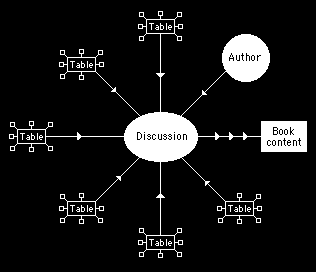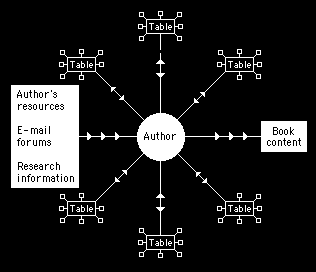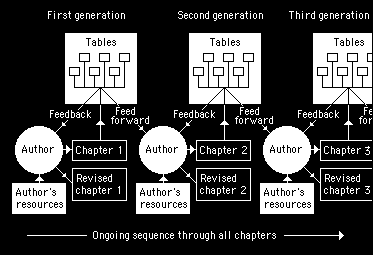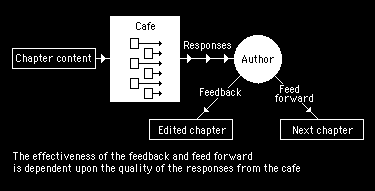

Using a virtual cafe
by Peter Small
Using a cafe to write books
In the link 'Virtual cafes', I describe a technique of using the Internet to create a virtual cafe. This consists of several small Internet discussion forums (each with about eight participants). These discussion forums can be likened to tables in a cafe where groups of people debate a common subject.
It occurred to me that this might be a good way to write books. If I could get people at several tables in a virtual cafe to read and discuss every chapter as I wrote them, I would be able to listen to their comments and criticisms. I would be able to see how they were understanding what I was writing. I'd be able to see what was needed to be explained further or differently. They would be able to offer suggestions for the following chapters. It seemed workable so I decided to give it a try when I began to write the book "The Entrepreneurial Web".
The first thing I did was to mail all my list of contacts asking if any of them would like to read and comment on the chapters of a book as I wrote them. About forty agreed to take part. I then added to these a number of people from various e-mail discussion forums that I belonged to: those whom I knew were actively involved in one way or another in the e-business world. I then had a full cafe of readers and randomly divided them up into six tables with about eight to each table.
The people in the cafe were an ideal cross section of the type of readers the book would be aimed at, they were about as mixed as it is possible to get. Not only were they typical of the readership, they also each had unique knowledge that could contribute valuable input to the book. They included application developers, programmers, entrepreneurs, Web site designers, database specialists, hardware specialists, marketers, business executives, technical writers, teachers, students.. They were a random selection of people who weren't all e-business experts but in one way or another worked or studied in the e-business environment. The only thing they had in common was experience in using e-mail discussion forums.
In effect, the cafe consisted of six small-world clusters where the members of each cluster had extensive links to a large number of areas in the world of e-business.
The cafe as a problem solver
When I first explained the idea of the cafe to the readers, many were under the impression that the content of the book would be a joint effort – where all the readers provided input and between us we'd decide what were the best ideas and meld those into a strategy by common agreement. This conception is illustrated in figure 1, where each table is seen as discussing ideas separately, then for these ideas to go into a common pool where everyone could take part in deciding which ideas were valid and which ideas were not. This strategy would be similar to conventional ways of working, which involves combining the outcomes of special project groups or think tanks.

Figure 1 - Some participants in the cafe, initially thought the cafe´ was designed to generate ideas that would be selected from through joint discussion and decision making
This system, of inputting many different ideas and using the combined experience of many to decide amongst them, works well in a stable environment – when there are not too many unknowns and uncertainties. In a situation involving more knowledge than any single person can possess and includes many unknowns and uncertainties it is difficult to obtain any consensus. Usually, the discussions break into irreconcilable factions. Worse still, when the subject matter is largely intangible – about thinking and strategy – there are usually as many different opinions as there are people and it is difficult even to agree about what it is that has to be decided upon.
The use I had in mind for the cafe was quite different from most people's expectations. I saw the cafe as a problem solving device, with the role of the author being that of a catalyst in a self evolving system. The author would introduce ideas and information into the system by means of book chapters. These would be passed, one at a time, to each table separately – for each person to contemplate individually. With each chapter, everyone would speculate upon what was implied and where it was leading. They would collaborate by writing down their own impressions and let others comment on their observations. All these comments and discussions would then form the basis for writing the next chapter. This system is illustrated in figure 2.

Figure 2 - Chapters are passed separately to a number of tables. The people at the tables collaborated by applying this knowledge to themselves as individuals and sharing these thoughts with the others at their table
This is much in line with the process of collaborative learning. The readers weren't meant to convince each other of the validity of their own thinking, they were collaborating by each offering up their thoughts so that others might compare them with their own. This can be likened to the technique of collaborating by soliloquising as described in a previous chapter. In fact, this led to more than soliloquies, it sparked off many informative discussions, where people at the tables often changed or modified their original viewpoints and perspectives.
It was this element of collaborative learning that maintained the review readers' interests. Once they discovered it wasn't just about commenting and criticising a book, but an exercise where they could expand and develop their own thinking, it grabbed their imaginations. Instead of simply reading an author's views they were part of a system that was developing a solution.
What was very hard for most people to adjust to though was that it wasn't intended that they should have to have a common agreement on the validity or applicability of the chapter contents. They each had to give an opinion as to how it affected or influenced them personally. They each had unique situations, unique experiences and knowledge; it couldn't be expected that they would all agree on a common viewpoint.
What was required was for each person at the tables to give some indication as to how the information was affecting their own individual conception of the e-business environment. Explaining to the others how it related to their local situation, where it was leading their thinking and what knowledge gaps it was exposing.
At the beginning, most people in the cafe wanted a synopsis of what the book was about and a few signposts to indicate the direction the book would take. They were a little bemused when I explained I had no idea what the book would contain until it was finished as the content would evolve as it went along. All I could give them was a description of the final goal: finding a way to think about the environment of the Internet to be able to make full and profitable use of it.
Not surprisingly, they were somewhat alarmed when I told them that I didn't have an answer to this problem yet, but, this evolutionary approach to writing a book was designed to find out. Some of the cafe´ members dropped out at this stage. It didn't seem any point to them that they should read and comment on the chapters of a book where the author seemed to know even less than they did.
Others were more sanguine about the project, although they weren't sure how this would turn out they decided to stick with it for a while to see what happened. There were also several people who had read my previous books and were familiar with my evolutionary approach to problem solving. They had a little more faith.
The principle was very simple, you start from any point and through a process of steps, proceed towards a satisfactory solution. At the end of each step, stock is taken and a new direction explored. In this way, there is a relentlessly progress towards the intended goal. The steps in this book writing process are chapters, each equivalent to a generation in an evolving system. This is illustrated in figure 3.

Figure 3 - The approach to reaching a conclusion through writing a book is by means of a number of chapters. These chapters act as a set of ideas that evolve over a number of generations
Understanding how the process of evolution takes place is not intuitive. As one scientist famously remarked, "Evolution has been around for so long that most people think they understand it". The reason why evolution is so hard to understand is that account has to be taken of progress that takes place in the future.
Think of the conventional way a book might be written. The author will write the draft manuscript, then this draft will be sent to reviewers for their comments and criticisms. In light of those comments and criticisms, the author will make changes and corrections. It would be unusual for the author to say, "Hey, those comments gave me an idea to write a different kind of book, I'll start again". Imagine now, instead of the author sending out a whole manuscript to reviewers, it is sent out a chapter at a time. And at each new chapter the author thinks, "Hey, those comments gave me an idea to write the book a different way, I'll change direction in the next chapter". This is what happens when a book is written with an evolutionary strategy.
This is illustrated in figure 3, where an author submits each chapter to the tables in the cafe and gets feedback and feed forward. Conventional feedback allows changes to be made to the current chapter being read. These changes correct only factual errors or improve clarification; this conventional feedback is not used to alter the main content. For better or worse, the original content is retained because it represents a record of the thinking processes at that chapter. This cannot be changed because the following chapter builds upon it. Changes in thinking or direction emanate from the feed forward, this affects not the current chapter, but, the following chapter that has yet to be written.
This is also illustrated in figure 3, where it shows each chapter representing a new generation in an evolving solution. At the end of each generation – chapter – the author takes the next step in a direction highly dependent upon the feed forward from the previous generation. Altering the previous chapter in the light of feed forward would make as much sense as the evolutionary process going back in time to modify a previous generation. Evolution acts by changing future designs, not by acting retrospectively on the past.
This evolutionary process used for book writing means that ambiguities, doubts, uncertainties, knowledge gaps and differences of opinions expressed by readers are not used to modify the chapter that they apply to. They provide a starting place for the next chapter and are answered there.
Making corrections in future chapters allows the book to progress in much the same way as species evolve in a biological ecosystem: a gradual progression towards a solution to a problem. In the case of a species, the solution is in answer to the problem of success and survival in a highly competitive biological environment.
The cafe as a guidance system
Figure 4 illustrates the activity at the end of each chapter (the pause times between the generations of an ongoing evolutionary process). The chapter content is sent to each table in the cafe. Each person at a table responds to the content by posting comments and opinions to all others at their table. Often these responses will trigger a discussion with several people joining in.

Figure 4 - The direction and content of the book is heavily influenced by the feed forward of the responses from the people at the tables in the cafe. This acts as an intelligent control system to drive the direction of the book
An author, using this system to write a book, will effectively be sitting at each table and receiving a copy of all posts. This intelligence will be divided into two categories: feedback and feed forward with the feed forward directing the new direction of the book in the next chapter.
Note: this is continued in the link 'Organic intelligence systems'.